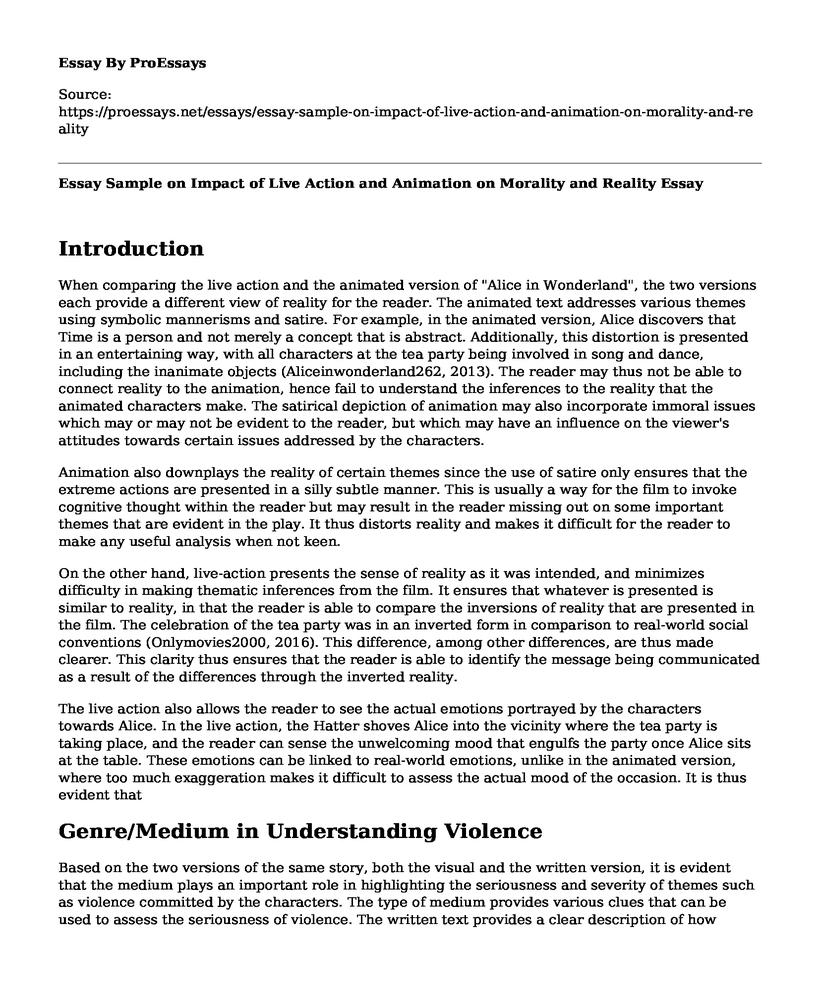Introduction
When comparing the live action and the animated version of "Alice in Wonderland", the two versions each provide a different view of reality for the reader. The animated text addresses various themes using symbolic mannerisms and satire. For example, in the animated version, Alice discovers that Time is a person and not merely a concept that is abstract. Additionally, this distortion is presented in an entertaining way, with all characters at the tea party being involved in song and dance, including the inanimate objects (Aliceinwonderland262, 2013). The reader may thus not be able to connect reality to the animation, hence fail to understand the inferences to the reality that the animated characters make. The satirical depiction of animation may also incorporate immoral issues which may or may not be evident to the reader, but which may have an influence on the viewer's attitudes towards certain issues addressed by the characters.
Animation also downplays the reality of certain themes since the use of satire only ensures that the extreme actions are presented in a silly subtle manner. This is usually a way for the film to invoke cognitive thought within the reader but may result in the reader missing out on some important themes that are evident in the play. It thus distorts reality and makes it difficult for the reader to make any useful analysis when not keen.
On the other hand, live-action presents the sense of reality as it was intended, and minimizes difficulty in making thematic inferences from the film. It ensures that whatever is presented is similar to reality, in that the reader is able to compare the inversions of reality that are presented in the film. The celebration of the tea party was in an inverted form in comparison to real-world social conventions (Onlymovies2000, 2016). This difference, among other differences, are thus made clearer. This clarity thus ensures that the reader is able to identify the message being communicated as a result of the differences through the inverted reality.
The live action also allows the reader to see the actual emotions portrayed by the characters towards Alice. In the live action, the Hatter shoves Alice into the vicinity where the tea party is taking place, and the reader can sense the unwelcoming mood that engulfs the party once Alice sits at the table. These emotions can be linked to real-world emotions, unlike in the animated version, where too much exaggeration makes it difficult to assess the actual mood of the occasion. It is thus evident that
Genre/Medium in Understanding Violence
Based on the two versions of the same story, both the visual and the written version, it is evident that the medium plays an important role in highlighting the seriousness and severity of themes such as violence committed by the characters. The type of medium provides various clues that can be used to assess the seriousness of violence. The written text provides a clear description of how actions were executed and the mood presented at a particular time to give a clear picture of how and why the violence occurred. There is collective proof of how the violence is conducted, therefore providing the reader with a chance to gauge the severity based on available proof. A visual medium provides visual evidence of the happenings, hence presenting the violence and the effects to determine its severity. Both media thus provide the relevant information for a reader to assess the intensity of damage through conversations among the characters. In comparing the text "Alice in Wonderland" to the visual media of the tea party scene, the poor treatment that Alice is accorded is evident in both, although both media may require different levels of understanding in order to make an analysis.
References
Aliceinwonderland262. (28 September 2013). .Alice in Wonderland Mad Tea Party. Retrieved from https://www.youtube.com/watch?v=msvOUUgv6m8
Onlymovies2000. (7 January 2016). Alice in Wonderland Tea Party. Retrieved from https://youtu.be/-1mAb2wXsRM
Cite this page
Essay Sample on Impact of Live Action and Animation on Morality and Reality. (2022, Mar 27). Retrieved from https://proessays.net/essays/essay-sample-on-impact-of-live-action-and-animation-on-morality-and-reality
If you are the original author of this essay and no longer wish to have it published on the ProEssays website, please click below to request its removal:
- Questions and Answers on Kant
- Plato and Aristotle on the Nature of Knowledge Essay
- Artists View Photography Essay
- Essay Example on Realist Art: Reflections of Social Struggles
- History of Photography Essay
- Essay Sample on Unlock the Power of Electronic Communication: WhatsApp, Facebook and Twitter
- Essay on Maria Rodriquez Reviving the Fashion Industry with Innovation and Experience







